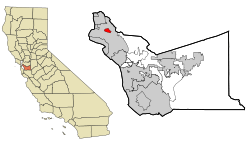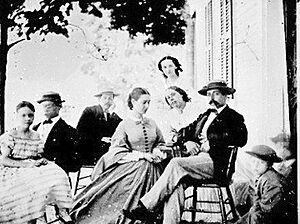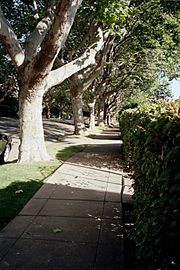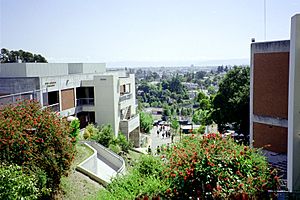Piedmont, California facts for kids
Quick facts for kids
Piedmont
|
|
|---|---|

The 1878 historic Wetmore House in central Piedmont
|
|

Location in Alameda County and the state of California
|
|
| Country | United States |
| State | California |
| County | Alameda |
| Incorporated | January 31, 1907 |
| Area | |
| • Total | 1.70 sq mi (4.40 km2) |
| • Land | 1.70 sq mi (4.40 km2) |
| • Water | 0.00 sq mi (0.00 km2) 0% |
| Elevation | 331 ft (101 m) |
| Population
(2020)
|
|
| • Total | 11,270 |
| • Density | 6,629/sq mi (2,561/km2) |
| Time zone | UTC-8 (Pacific (PST)) |
| • Summer (DST) | UTC-7 (PDT) |
| ZIP code |
94602, 94610, 94611, 94618
|
| Area code(s) | 510, 341 |
| FIPS code | 06-56938 |
| GNIS feature IDs | 1659383, 2411418 |
Piedmont is a small city in Alameda County, California, United States. It is completely surrounded by the city of Oakland. In 2020, about 11,270 people lived there. The name "Piedmont" comes from a region in Italy and means 'foothill'. Piedmont became an official city in 1907 and grew a lot in the 1920s and 1930s.
Contents
History of Piedmont

The area known as Piedmont used to be larger than the city we know today. It even included the Mountain View Cemetery.
In 1907, people living in Piedmont voted to become a separate city. They chose not to become a neighborhood within Oakland.
During the 1920s, Piedmont was known as the "City of Millionaires." This was because it had more millionaires per square mile than any other city in the U.S. Many of the large, fancy houses built by these millionaires are still standing today. On December 18, 1922, Piedmont became a charter city. This means it has its own special rules, or charter, that can only be changed by a vote of the people.
In the past, Piedmont had rules that made it difficult for people of different races to live there. For example, in 1924, an African-American family, Sidney and Irene Dearing, bought a home using a white family member to help them. They faced threats and were eventually forced to sell their home to the city. In 2021, the city council said they would apologize for how the Dearing family was treated.
In 2017, the mayor of Piedmont, Jeffrey Wieler, resigned. This happened after he made some upsetting posts on social media.
Geography of Piedmont
Piedmont is located near the Hayward Fault. This is a geological fault line that runs through the East Bay area. The city covers about 1.7 square miles (4.4 square kilometers), and all of it is land.
Piedmont's Borders
Piedmont is completely surrounded by the city of Oakland. Its borders touch different Oakland neighborhoods. For example, to the northwest, it's next to Oakland's Piedmont Avenue shopping area. To the southwest, it borders Oakland's Grand Lake District.
Major Streets in Piedmont
Some important streets in Piedmont include Oakland Avenue, which goes through the city center. Highland Avenue divides Piedmont into upper and lower parts. Moraga Avenue runs along the northern edge of the city. Grand Avenue is near the western border. Generally, homes in upper Piedmont have larger yards.
Piedmont does not have any major highways running through it. However, entrances to Highway 13 and Interstate 580 are very close by.
Housing and Services
Most of Piedmont is set up for single-family homes. This means there are not many businesses or apartment buildings. The city gets most of its money from property taxes to pay for public services.
Piedmont has its own fire department, police, parks, and recreation services. However, it shares a public library and post office with Oakland.
Population and Demographics
| Historical population | |||
|---|---|---|---|
| Census | Pop. | %± | |
| 1890 | 634 | — | |
| 1910 | 1,719 | — | |
| 1920 | 4,282 | 149.1% | |
| 1930 | 9,333 | 118.0% | |
| 1940 | 9,866 | 5.7% | |
| 1950 | 10,132 | 2.7% | |
| 1960 | 11,117 | 9.7% | |
| 1970 | 10,917 | −1.8% | |
| 1980 | 10,498 | −3.8% | |
| 1990 | 10,602 | 1.0% | |
| 2000 | 10,952 | 3.3% | |
| 2010 | 10,667 | −2.6% | |
| 2020 | 11,270 | 5.7% | |
| 2023 (est.) | 10,635 | −0.3% | |
| U.S. Decennial Census | |||
Piedmont's Population in 2010
In 2010, Piedmont had a population of 10,667 people. Most residents (74.2%) were White, and 18.2% were Asian. About 3.9% of the population was Hispanic or Latino.
There were 3,801 households in Piedmont. Many households (42.3%) had children under 18 living in them. Most households (72.0%) were married couples. The average household had about 2.81 people.
The population's age spread was diverse. About 28.3% of residents were under 18. About 15.4% were 65 years or older. The average age was 46.2 years.
Most homes in Piedmont (88.3%) were owned by the people living in them. About 11.7% of homes were rented.
Arts and Culture
Piedmont has several public buildings and parks. These include a City Hall, Community Hall, and a Recreation Center. Parks like Piedmont Park, Dracena Park, and Crocker Park offer green spaces. There are also playfields for sports.
The city hosts fun events throughout the year. These include the July 4 Parade, Movies in the Park, and a Harvest Festival. Piedmont High School is famous for its annual Bird Calling Contest. This contest has even been featured on national TV shows!
Many groups help make Piedmont a great place. These include the Piedmont Education Foundation and the Piedmont Historical Society. There are also groups for sports, arts, and community support.
Education in Piedmont
Students living in Piedmont attend schools within the Piedmont Unified School District. This district includes three elementary schools (Havens, Beach, and Wildwood). It also has one middle school (Piedmont Middle School) and two high schools. The high schools are Piedmont High School and Millennium High School. Many graduates from Piedmont High School go on to attend four-year colleges and universities.
The Piedmont Unified School District is considered one of the top school districts in California.
Voters in Piedmont have approved special taxes to improve school buildings. These taxes help make sure schools are safe, especially from earthquakes. They also help keep school facilities modern. For example, the sports complex, Witter Field, was rebuilt.
Piedmont voters also approve a special annual tax to help pay for the schools' daily operations. This tax makes up a big part of the school district's budget.
Piedmont High School is home to the yearly Leonard J. Waxdeck Bird Calling Contest. The top winners used to appear on the Late Show with David Letterman.
The Piedmont Educational Foundation gives money to support new ideas in Piedmont schools. It also helps fund the school district's operations.
Media
Piedmont has two local weekly newspapers. These are the Piedmont Post and the Piedmonter.
Transportation
AC Transit provides bus service in Piedmont. Bus routes connect Piedmont to Oakland's BART train stations. There is also a special bus route, Route P, that goes to Downtown San Francisco during busy commute times.
Piedmont in Pop Culture
The city of Piedmont was featured in the Disney show Gravity Falls. It was the hometown of the main characters, Dipper and Mabel Pines.
Notable People from Piedmont
Many famous people have lived in Piedmont. These include:
- Billie Joe Armstrong, lead singer of the band Green Day.
- Pete Docter, a director for Pixar films like Monsters, Inc. and Up.
- Clint Eastwood, a famous actor.
- Alex Hirsch, the creator of the animated TV series Gravity Falls.
- Jack London, a famous author who wrote Call of the Wild while living nearby.
- Robert S. McNamara, who was the Secretary of Defense for President John F. Kennedy.
- Bubba Paris, a former National Football League player for the San Francisco 49ers.
- Bill Romanowski, another former National Football League player.
- Charles R. Schwab, who founded the brokerage firm Charles Schwab.
- George Zimmer, the founder of Men's Wearhouse.
See also
 In Spanish: Piedmont (California) para niños
In Spanish: Piedmont (California) para niños






